Definitive Guide to Combining Antiques with Modern Furniture

When it comes to decor, most of us want our homes to reflect a style that is fresh and timeless. A space that is fashionable, but also classic. It may seem like a lot to ask, but it is possible! The secret is using a blend of antiques and modern furniture. Have you seen rooms created by professional designers and wondered how they do it? Well guess what, you don’t have to be a pro designer to achieve the look! Today we’re sharing our top 10 tips on how to artfully combine antiques with modern furniture.
This technique involves blending different decor. Before we dive in, let’s get clear on the design terminology for different styles and periods.
Design Terminology
Antique - An antique is a collectible item that has a high value because of its considerable age. An antique item is often defined as being at least 100 years old.
Vintage - Vintage is an item from a previous generation. A true vintage piece will be older than 50 years.
Traditional design - Traditional design is epitomized as elegant and comforting. This design style features classic lines and is largely influenced by the 18th and 19th century European decor. Traditional design style is harmonious, with matching furniture sets. The design style is perfect for those who love symmetry, classic art and antiques rich with history.
 Source: Decor Aid
Source: Decor Aid
Modern design - Modern design can refer to design from the Art deco period of the 1920’s all the way up to the vintage look of the 1970’s. Modern design was informed by Scandinavian and German Bauhaus styles. Silhouettes were streamlined and earthy palettes and natural materials like wood, leather and stone were used. The Mid Century Modern era of the mid 1930’s - 1960’s is an especially popular design style from the Modern era.
Mid-Century Modern (MCM) - The characteristics of Mid-Century Modern, or MCM, are sleek, clean lines with minimal fuss. This style features a lot of wood such as oak, teak, rosewood, walnut, beech and elm, as well as non-traditional materials such as metal, glass and lucite. There were many iconic MCM designers such as Charles and Ray Eames, Eero Saarinen, Herman Miller, Harry Bertoia, Isamu Noguchi who heavily influenced the period. Their designs (and even replicas) of these pieces are highly sought after today.
 Source: Curbed
Source: Curbed
Modern Vintage - Modern Vintage is a marriage of old and new. Think modern furniture with vintage accessories.
Contemporary design - Contemporary design encompasses the latter half of the 20th century, including the present. It features clean lines (straighter and more austere than modern) and utilizes materials like steel, glass and concrete.
 Source: Freshome
Source: Freshome
Rustic - Rustic design emphasizes the natural. The style is cozy and inviting, it’s all about bringing the outdoors in. Think rough-hewn beams and organic materials like wood, stone, burlap and canvas - often in an unfinished and raw state. Rustic design encompasses many design styles like cabin, coastal, country and farmhouse.
Farmhouse - Farmhouse Style is a fresh take on country living. It’s a warm and cozy style that takes a cue from rustic decor and incorporates vintage and flea market finds as well as modern touches. The style features chalkboards, galvanized steel, repurposed accessories and big, comfortable furniture.
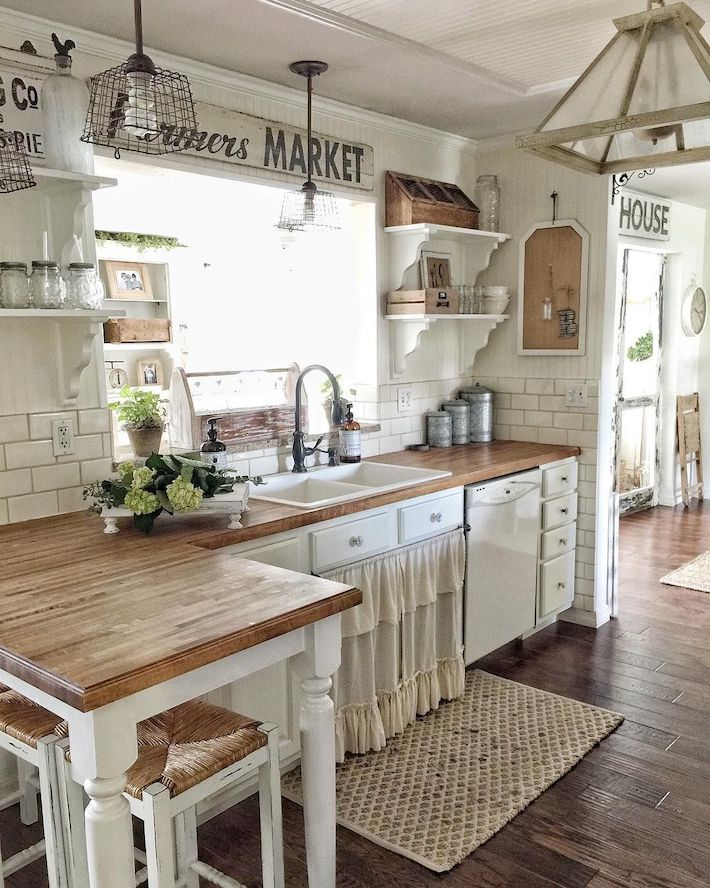 Source: Simply French Market
Source: Simply French Market
Industrial - Industrial style was inspired by industrial warehouses and factories. This “unfinished” style showcases the industrial structure of the building and its raw, unrefined edges. Exposed structural and mechanical features like pipes and beams, concrete, brick, wood and metal are showcased; as well as utilitarian objects and metal light fixtures.
 Source: The Wow Decor
Source: The Wow Decor
Now that we're clear on the design styles, let's get into the tips!
Top 10 Tips for Combining Antiques with Modern Furniture
Tip # 1 - Balance and Proportion
Our top tip for mixing antiques with modern furniture is to pay attention to the balance and proportion of the blended styles. Keeping balance and proportion is the golden rule of interior design. It applies to style, as well as color, shape and texture. Mastering this guiding principle is the key to thoughtful design. Wondering where to start? Start with the end in mind. It’s helpful to have an inspiration for the room you are creating before you begin designing it.
For instance you could:
- • Mingle antique furniture with modern accessories
- • Incorporate modern furniture with antique accessories
- • Weave a combination of styles such as Farmhouse and MCM with antique showpieces
- • Focus on a theme such as “mountain cabin”, “shades of white”
If you’re not sure where to start, visit your favorite store’s showroom, or look through our Pinterest to try and find one or multiple images that resonate with you.
Tip #2 - Opposites Attract
The contrast of antiques and modern decor together is so intriguing! A great rule of thumb is to group contrasting periods together. For instance, you might have antique bedside tables with modern lamps, or antique lamps with modern bedside tables. In the office you could have an antique desk with a modern chair, or perhaps antique art with a new sofa in your living room.
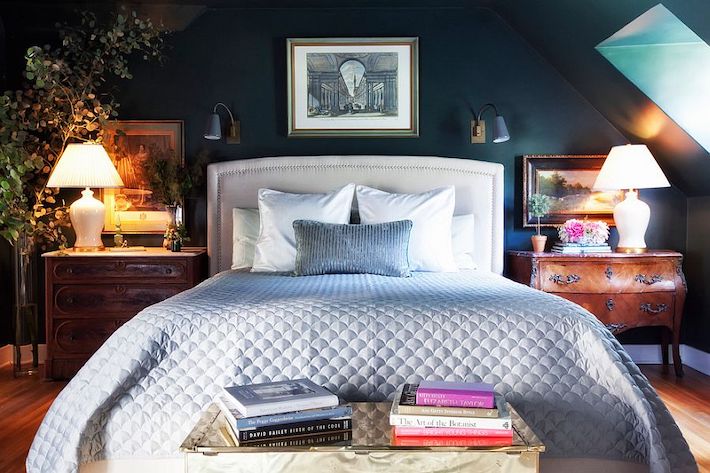 Source: Decoist
Source: Decoist
Tip #3 - The 80/20 Rule
Amalgamating modern and traditional styles is the best way to make a room that is both fresh and timeless. That said, the skillful way to achieve this look is to go with predominantly one style, and add accents of the other. This is the 80/20 rule. For instance, you might have a room with 80% modern furnishings and then add in a stunning crystal chandelier.
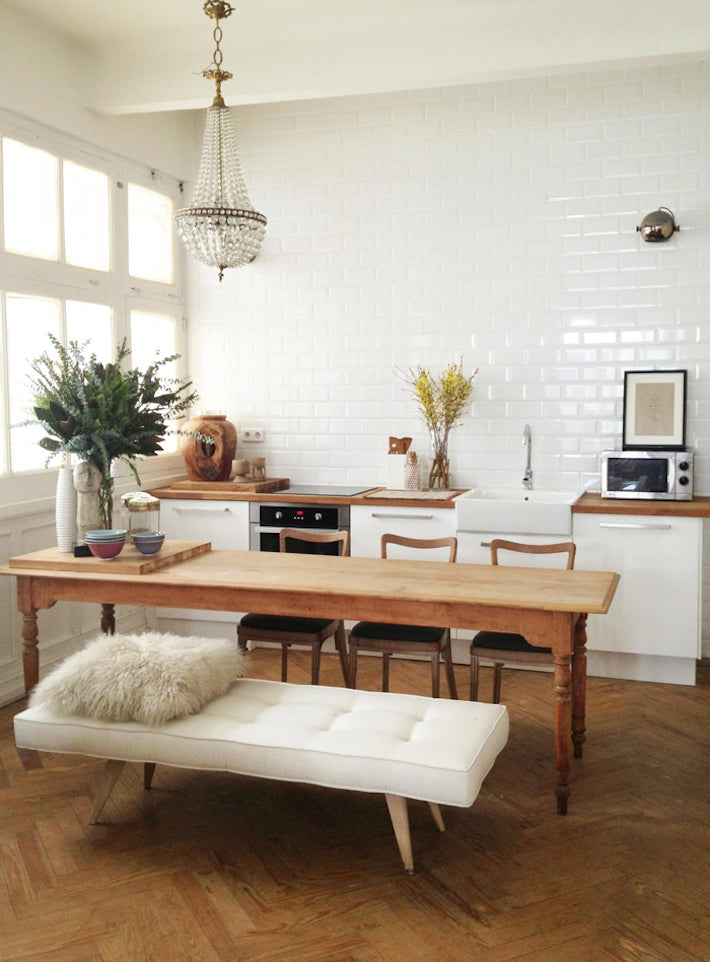 Source: Las Cositas de Beau & eau
Source: Las Cositas de Beau & eau
This rule goes both ways. Here is a predominantly vintage room with a pop of industrial seen through the pendant lamp and bold lettered signage. It’s all about showcasing the dynamic tension that exists between different periods and styles.
 Source: alleideen
Source: alleideen
Tip #4 - Repetition is Key
When combining antiques with modern or contemporary furniture, nothing needs to be matched exactly, but make sure to align and repeat the design elements that you use. Everything needs to have a buddy. For instance, here we see the blue tones from the hero painting are repeated in the furniture and accessories. As well, the wood tone on the side table is repeated in the dining room chair legs and the tray on the coffee table.
 Source: Style by Emily Henderson
Source: Style by Emily Henderson
Tip #5 - Let the Odd Piece Shine
If you have an odd piece without a buddy, make it shine as the focal point of the room. For example, if something is much larger in scale than anything else in the room, it will stand out as a focal point. In this room, the oversized chinese lantern and Baroque mirror are the focal pieces.
Here’s how pro designer Leanne Ford styled it:
 Source: Leanne Ford
Source: Leanne Ford
Tip #6 - Layer Periods
While it’s easy to get caught up in the trap of focusing on one design period, the most intriguing rooms use a blend of antique and modern decor. Different styles can be layered together for a captivating finished look. Wondering which room in your house to try this out in? We especially love the blended combination of Farmhouse and MCM in the dining room with traditional antique pieces.
Here we see traditional landscape paintings and a traditional, antique table combined with an antique dining room table and replica MCM Eames dining chairs.
 Source: decor8
Source: decor8
In this picture a beautiful rustic, farmhouse table is juxtaposed with traditional chairs, and an antique round table, distressed mirror and a modern light fixture.
 Source: Sf Girl
Source: Sf Girl
This look highlights the use of mixed antique, vintage Thonet and modern chairs with a farmhouse table and industrial pendant lights.
 Source: Merchant Design
Source: Merchant Design
Tip #7 - Pick a Dominant Wood Tone
Yes, you can mix furniture that use different woods. The trick is to pick a dominant wood tone as a connecting point. If you have wood floors let their tone guide the way, otherwise focus on your largest furniture piece and observe whether it has warm, cool or neutral wood tones. Warm tones appear to be red, orange or yellow. Cool tones look grayish, green or blue. Neutral undertones are beige and go with both warm and cool tones of wood.
In this living room by award-winning designer Charlie Ferrer, warm mid-tone wood pieces unify the look. Ferrer took the continuity of the tone one step further by consolidating it with the monumental 1940’s kilim rug. A rug acts as a buffer to smooth the transition between wood elements. This is especially important for placing wood furniture on wooden floors. Without a rug, wooden furniture with a similar tone to the floors ends up looking washed out. It’s equally troublesome to place a wooden piece directly on top of a wooden floor with a different tone, as the disparity is immediately perceivable.
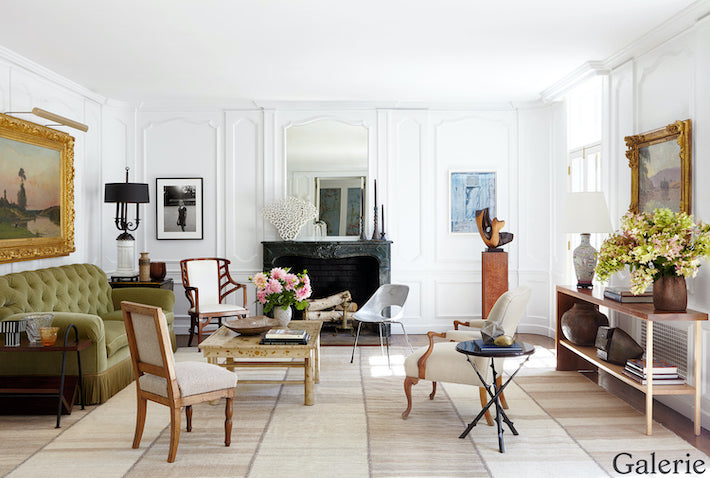 Source: Ferrer
Source: Ferrer
Tip #8 - Balance the Scale of Objects
The scale of objects refers to their size in comparison with other objects in the space. The trick is to balance lighter items by grounding them next to heavier ones. Dainty items like this settee and coffee table are anchored in the space with this heavier side table and fringed velvet sofa.
 Source: Ferrer
Source: Ferrer
Tip #9 - Mix Materials
In the same way that balancing the scale of objects and design periods is important, you also want to commingle the materials that you use in a room. A bit of contrast works best. Here we see a sleek mid-century modern Saarinen-style tulip table paired with rustic rattan armchairs and Thonet Chairs. The tulip table is an especially versatile piece as it also counterbalances the traditional look of the room. The result is a perfect blend of antique and modern furniture.
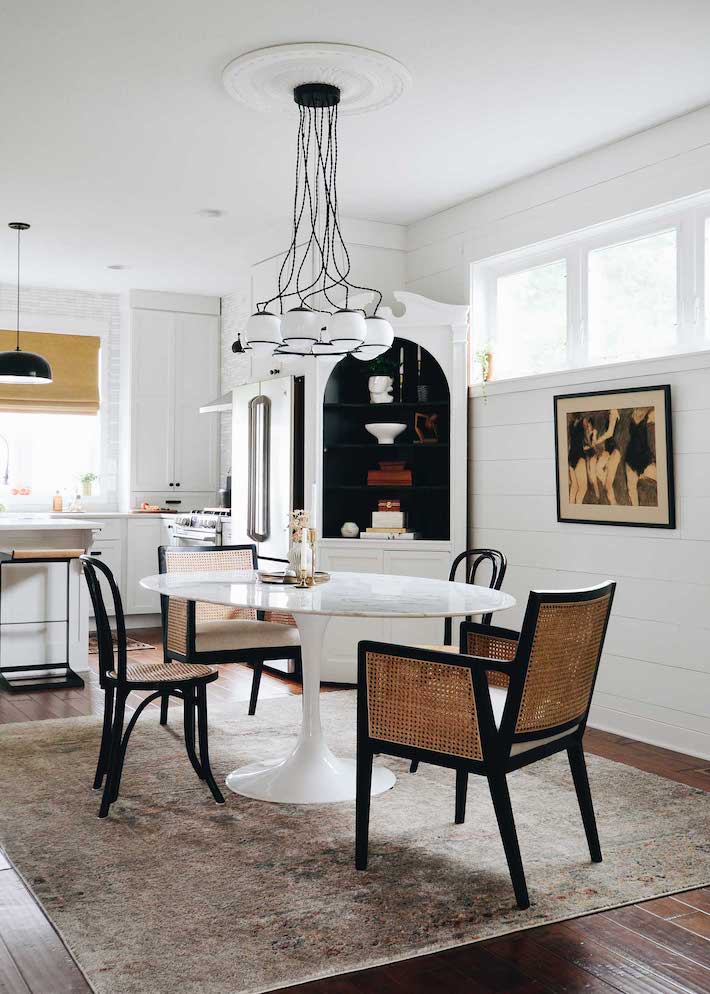 Source: Style By Emily Henderson
Source: Style By Emily Henderson
Tip #10 - Repurpose Antiques
The value of antiques lies in their history. The journey of finding and repurposing antiques will enrich your home with so much character! When you upcycle or repurpose, the item you are using becomes even more functional and beautiful than what it previously was. This repurposed dresser makes for such a standout powder room vanity! Browse our collection of custom-designed and repurposed antiques for more inspiration.
 Source: Style by Emily Henderson
Source: Style by Emily Henderson
Review the Top 10 Tips
In summary, this look is all about balancing the styles. Here’s a handy recap of our top tips.
Tip #1 - Start with the end in mind. It’s helpful to have an inspiration for the room you are creating before you begin designing it.
Tip #2 - Remember that opposites attract, group contrasting periods together.
Tip #3 - The 80/20 Rule: work with predominantly one style, and add accents of the other.
Tip #4 - Make sure to align and repeat the design elements that you use. Everything needs to have a buddy.
Tip #5 - If you have an odd piece or something is much larger in scale than anything else in the room, make it shine as the focal point.
Tip #6 - Layer different styles together for a captivating finished look. The most intriguing rooms use a blend of antique and modern furniture.
Tip #7 - Pick a dominant wood tone and make sure to use a great rug to consolidate the look.
Tip #8 - Balance the scale of objects; place lighter furniture next to heavier pieces.
Tip #9 - Mix materials: a bit of contrast is best.
Tip #10 - Repurpose antiques to add character and increase their functionality.
So there you have it, our top 10 tips for how to mix antique and modern decor!
Next →
← Previous

